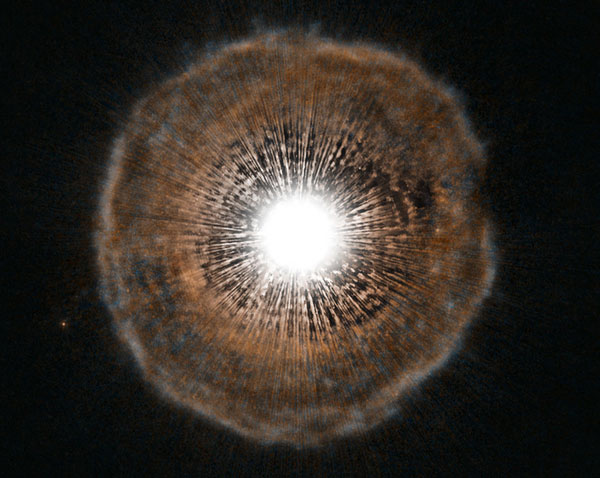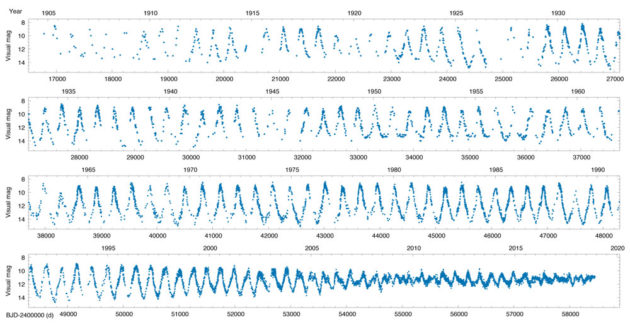The amateur observers of the AAVSO monitored the star T Ursae Minoris for a century. Now, astronomers think they can explain the star's recent change in behavior.

ESA / Hubble / NASA / H. Olofsson (Onsala Space Observatory)
The lifetime of a Sun-like star is 100 million times longer than that of a typical human. It’s no wonder the stars appear eternal — most evolutionary changes occur on timescales far too long for us to observe directly.
But one rare phase of stellar of evolution occurs so quickly — over decades rather than millennia or longer — that mere humans can watch it happen. And in the case of the red giant star designated T Ursae Minoris (T UMi for short), most of the humans doing the watching were amateur astronomers.
A Star for the Ages
The American Association of Variable Star Observers (AAVSO) has been watching T UMi since the star’s brightness variations were discovered in 1912. Ultimately, they amassed more than 100 years of observations. When seen together in a single graph, those observations reveal an intriguing pattern.
For the first few decades, the star’s brightness varied in a semi-regular way, changing by 4 to 5½ magnitudes over the course of 300 to 330 days. But over the past 20 years, this pattern has changed to a more rapid cycle. The star now brightens and fades by only 1.5 to 2 magnitudes over a period of roughly 200 days. Astronomers noting this change have proposed that the star is undergoing a rare and, from a stellar perspective, short-lived change in structure.

Now, László Molnár (Konkoly Observatory, Hungary) and colleagues have taken the century-long observations collected by amateur astronomers (what the researchers term “slow science”) and applied state-of-the-art computer simulations to understand the star’s inner structure. The results appear in the Astrophysical Journal. (Full text is available here.)
T UMi is a red giant star whose center is stuffed full of carbon and oxygen. Because the star isn’t massive enough, its core is inert — it will never fuse again. Instead, the star supports itself against gravity by fusing hydrogen into helium in a shell around the core. The helium stockpile builds up until it ignites. This flash briefly expands the inner regions of the star so much that it temporarily extinguishes the hydrogen-burning shell and shrinks the outer layers. The star as a whole dims and contracts. The star’s smaller radius means that its pulsations shrink, too.
As the star contracted, a second pulsation mode appeared in the star. While the fundamental period of the star’s brightness changes is now roughly 200 days, there’s an “overtone” of changes that occur on a 111-day timescale. AAVSO observations were crucial to seeing this overtone, and the overtone is in turn crucial to understanding the star’s interior.
Explaining the Past, Predicting the Future
Molnár and colleagues use their model of the star’s structure to deduce its characteristics: T UMi is 2 times the Sun’s mass but about 300 times the Sun’s diameter, and it appears to be about 1.2 billion years old.
Besides explaining the past few decades of this star’s behavior, the model predicts the next few decades as well. The researchers predict that the star’s contraction — and thus the decrease of its pulsation period — will last another 50 years, before the star begins expanding and brightening again. Observers of the AAVSO have their work cut out for them!
The model itself is designed to understand stellar evolution over billions of years, so it’s pretty incredible that it can predict behavior on decade-long timescales. The model enables the researchers to look further ahead, too. “We predict that T UMi will undergo about 5 to 10 more pulses before beginning its descent into the white dwarf phase,” says coauthor Meridith Joyce (Australian National University). “Each pulse cycle lasts a few hundred to thousand years, with ‘quiet’ phases in between.”
The current helium flash is accompanied by massive winds that carry off a major portion of the star’s outer layers. The researchers estimate that T UMi has already lost a sixth of its total mass in this way, although the mass loss wasn’t a focus of the current study. Ultimately, these shells of gas and dust will surround T UMi in a planetary nebula. T UMi will remain in the red giant phase for at least several hundred thousand years more, Joyce adds, before it transitions to a white dwarf.
“It is a sobering thought that even ‘rapid’ events, like the onset of thermal pulse in a star, are still measured in decades,” says Molnár. “It could take one's entire scientific career to finally prove, or disprove, this kind of prediction. Nevertheless, we plan to keep an eye on T UMi for the foreseeable future.”
 4
4









Comments
misha17
August 23, 2019 at 2:53 pm
If I read the article correctly, the star will remain in this phase of shorter period, lower variable brightness range for about 50 years, then will return to another phase similar to the pre-1995 pattern of period length and range of brightness; and the star will repeat this cycle of " 'longer period & larger brightness range' "/" 'shorter period & smaller brightness range' " about 6 more times before it goes to the white dwarf stage. Since we've only been consistently observing the star for a little over 100 years, how do we know we are in the first of the ~6 long/short period cycles and not in one of the later ones?
You must be logged in to post a comment.
laszlomolnar
August 23, 2019 at 4:48 pm
Our estimate puts it anywhere between 30-60 years, depending on the exact mass and other physical parameters. Check this figure in the original press release: (the 1.8, 2.0, and 2.2 solar mass lines are the best fits overall): https://www.aavso.org/sites/default/files/images/t_umi_model-comparison_en.png
It won't return to the same state after that though, it's gonna keep expanding for a century or more, probably reaching a period of 500-550 days, shrink back again (if it stays in this pulsation mode)... It's like a damped oscillator, and it's gonna reach a steady state again in about a millennium.
We know that it only has a few more thermal pulses left from our models: most of our runs that reproduced this particular pulse agreed that it's towards the later ones, and 3-10 more can be expected before it leaves the AGB and turns into a white dwarf.
You must be logged in to post a comment.
Donald-Sime
September 1, 2019 at 3:33 pm
I know that mass loss was not the focus of the current study, but
"2 Solar masses" and "1.2 billion years old" seem to be at odds, even with a 1/6 loss of total mass
Shouldn't it be, or have been, larger to become "a red giant star whose center is stuffed full of carbon and oxygen" in only 1.2 billion years?
You must be logged in to post a comment.
laszlomolnar
September 9, 2019 at 3:07 am
This would depend on several factors, including metallicity, initial mass, mass loss rate and even the internal physics on the RGB and AGB. The mass loss, in particular, is very hard to handle. The models that we calculated gave us 1.2+-0.2 billion years for the range of initial masses that fit the observed pulsation periods.
You must be logged in to post a comment.
You must be logged in to post a comment.